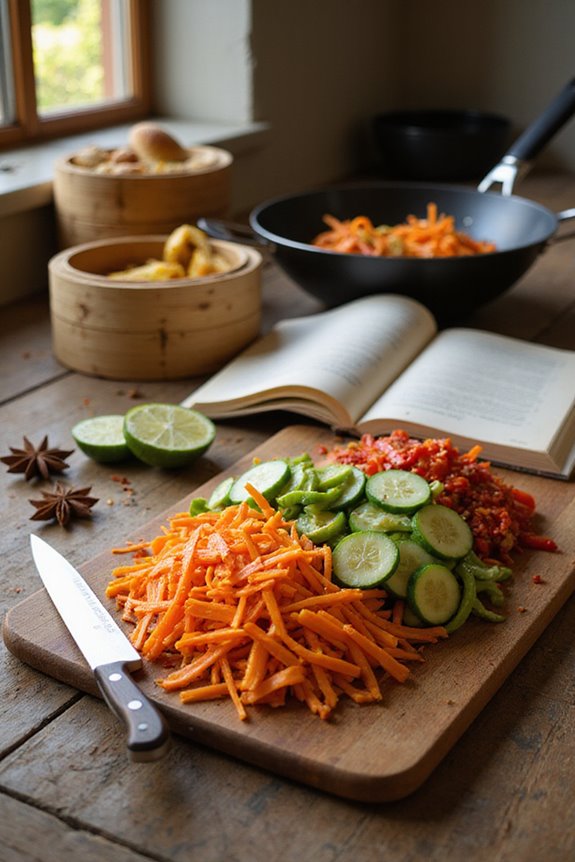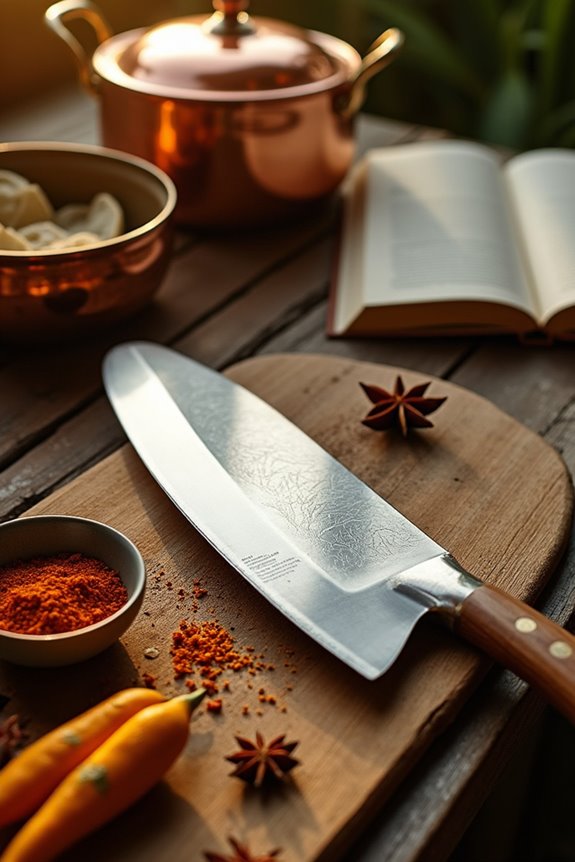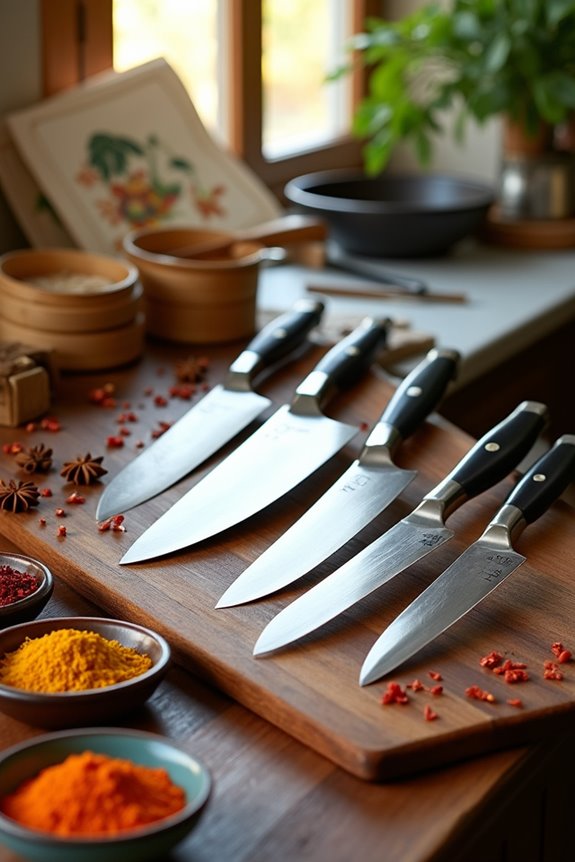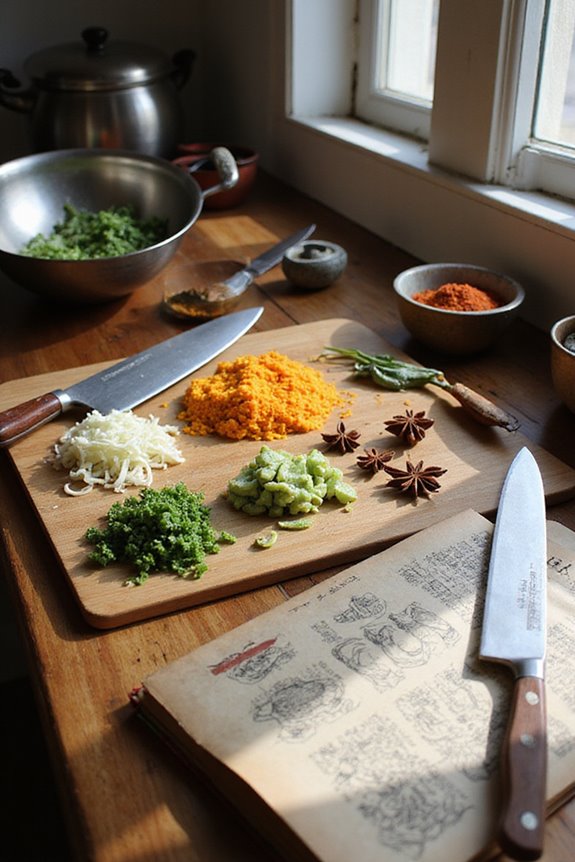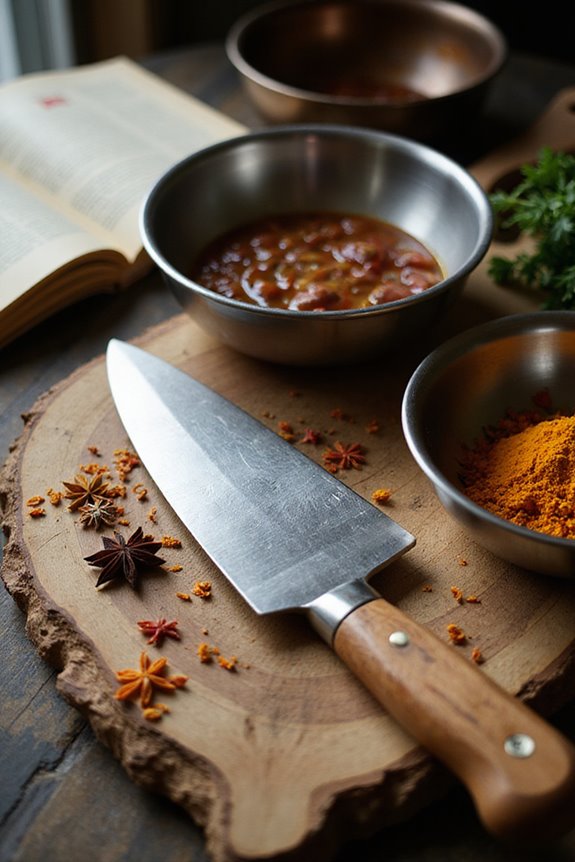To julienne vegetables properly, let’s gather our tools and get ready for some delightful chopping! First, wash and peel veggies like carrots or zucchini, then trim their ends for stability. Use a sharp Santoku knife and adopt the claw grip for safety. For those of us in a hurry, a julienne peeler works wonders too! Just slice down smoothly, and we’ll have magical, thin strips in no time. Stick around for more tips on choosing the best veggies!
Key Takeaways
- Wash and peel vegetables as necessary, ensuring they are fresh and firm for optimal cutting results.
- Use a sharp Santoku knife with a claw grip to ensure safety and control while cutting.
- Stabilize vegetables by trimming ends and creating a flat base before making julienne cuts.
- Measure strip sizes with a ruler for uniformity and employ smooth, even slicing motions.
- Consider using a julienne peeler for softer vegetables, ensuring to pull downward with straight strokes for consistent strips.
Essential Preparation Steps for Julienne Cutting
Before we plunge into the delightful world of julienne vegetables, let’s prepare our ingredients like the culinary magicians we are! To achieve that magical julienne cut, we need to focus on two key preparation methods: washing and shaping.
Here’s our game plan:
- Wash all veggies to kickstart freshness.
- Peel where needed (think carrots and beets!).
- Trim the ends to create stable surfaces.
For our vegetable selection, let’s pick firm friends like carrots and crunchy radishes, alongside soft zucchini and vibrant beets. A good mix of textures guarantees delightful bites. Investing in versatile tools enhances our preparation process, making julienning easier and more efficient.
Trust us, a well-prepped workspace makes all the difference. So, grab your tools, and let’s make vegetable magic happen!
Mastering Knife Technique for Julienne Cuts

Ready to slice and dice like a pro? Let’s focus on mastering our knife technique for those delightful julienne cuts! First, we’re all about knife selection. A Santoku knife, with its straight blade, is perfect for our veggie adventures. Remember, a sharp knife is a happy knife—keeping it polished guarantees clean, magical cuts. Additionally, using high-quality tools like a Chef’s Knife can enhance your efficiency and precision in the kitchen.
Now, let’s talk cutting technique! Using the claw grip will keep our fingers safe while maintaining control. For uniform strips, consider measuring with a ruler; it’s like giving our veggies holiday cheer! Finally, let’s make sure our vegetables are firm and fresh. This way, we’re not just cutting—we’re creating beautiful culinary masterpieces together! So grab your knife, and let’s make some veggie magic happen!
Utilizing a Julienne Peeler Effectively
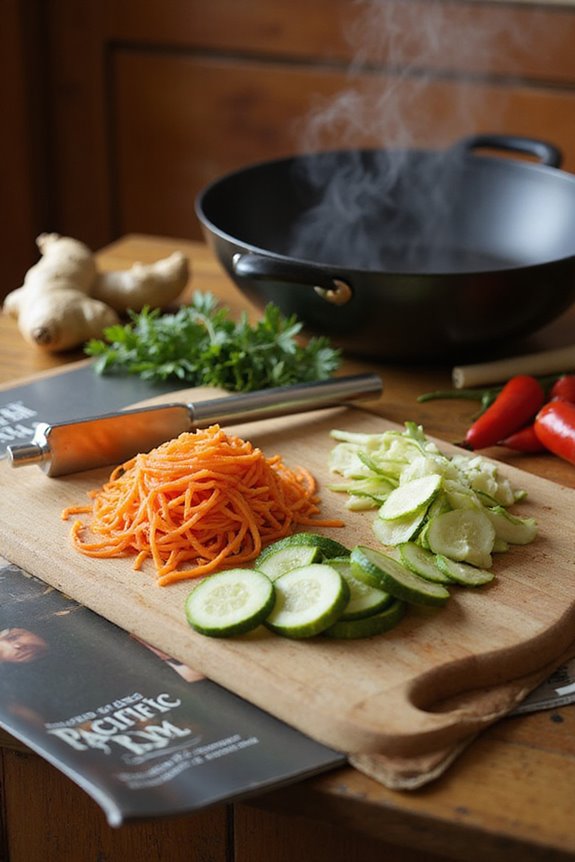
How can we make our vegetable prep even more exciting? Let’s explore the delightful world of julienne peelers! These magical tools have serrated blades, perfect for whipping up uniform strips like a pro.
Julienne Peeler Features:
- Dual-sided designs offer versatility—switch between standard peeling and julienne cutting!
- Y-shaped and swivel styles provide comfort, so our hands stay happy during prep.
Peeling Techniques:
- Start by securing our veggie on a flat surface.
- Pull the peeler downward smoothly, creating beautiful, even strips.
- For longer veggies, like carrots, peel in straight strokes.
And always remember, happy peeling brings delightful dishes to our tables—let’s julienne to our hearts’ content! Additionally, utilizing proper ergonomic designs ensures a comfortable grip, allowing for more efficient and enjoyable food preparation.
Choosing the Right Vegetables for Julienne Cutting
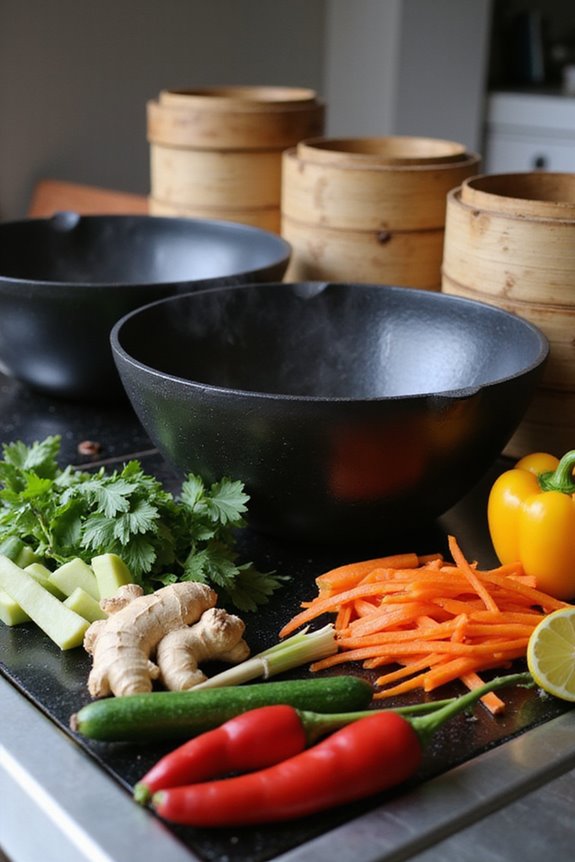
When we plunge into the magical world of julienne cutting, selecting the right vegetables is key to achieving those delightful, uniform strips that make our dishes pop! For a successful vegetable selection, we should aim for firm produce. Carrots and parsnips are absolute all-stars, while broccoli stalks and rutabagas shine brightly with their solid textures.
Here’s the scoop:
- Carrots: Perfectly crisp and easy to cut.
- Broccoli Stalks: Solid base for those fancy strips.
- Parsnips and Turnips: Reliable and versatile.
While soft veggies like zucchini can be fun, they often need extra care. Remember, sticking to firm root vegetables makes julienning a breeze—no holiday chaos here! Additionally, using a quality bamboo cutting board set can enhance your prep experience, making it efficient and enjoyable. So, let’s slice and dice our way to culinary success!
Safety Tips for Accurate Julienne Cuts
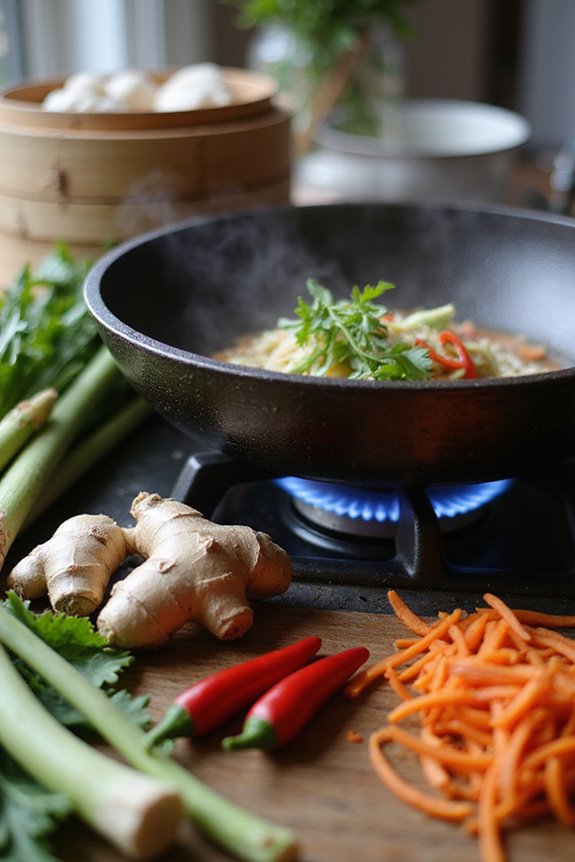
Safety tips are essential when julienning vegetables, and following them guarantees our kitchen adventures stay delightful and accident-free! To start, let’s focus on knife maintenance. Using a razor-sharp knife not only reduces slipping but also boosts our control. Don’t forget grip techniques; we should adopt the “claw grip” with our guiding hand to shield our fingers!
Next, let’s stabilize our vegetables. Slice off a small section for a sturdy base and keep a non-slip cutting board nearby. When we’re cutting, we’ll employ a smooth slicing motion rather than hacking away. Remember to take it slow—there’s no rush during our culinary escapades. With these tips, we’ll julienne like pros while keeping it safe and fun! Additionally, using quality utensils like disposable bamboo chopsticks can enhance your dining experience while ensuring you maintain sustainability in the kitchen.
Frequently Asked Questions
Can I Julienne Frozen Vegetables?
Imagine finding treasure in a frozen vegetable bag! While prep might be tricky, we can still use the julienne technique’s advantages to slice them up for soups or stir-fries, embracing creativity in our cooking adventures together!
What Are Alternative Cutting Techniques Besides Julienne?
When exploring alternative cutting techniques, we find the brunoise technique perfect for tiny cubes and the chiffonade method fantastic for delicate ribbons. These options elevate our cooking, adding flavor and visual appeal to our dishes together.
How Do I Store Julienned Vegetables?
When it comes to storing julienned vegetables, we’ve found that using airtight storage containers and following refrigeration tips keeps them fresh longer. Let’s wrap them in damp paper towels to maintain moisture while preventing sogginess.
Can I Julienne Fruits as Well?
Absolutely, we can julienne fruits too! Using proper techniques, we get delicious textures and benefits, enhancing our salads and desserts. Let’s explore this fun way to enjoy fruits together, combining taste with creativity!
What Is the Origin of the Julienne Cut?
When we explore the origin of the julienne cut, we discover its roots in French cuisine and timeless culinary techniques. This elegant method reflects our shared passion for precise, beautiful food preparation that connects us all.

